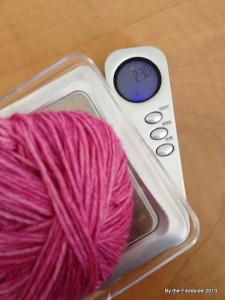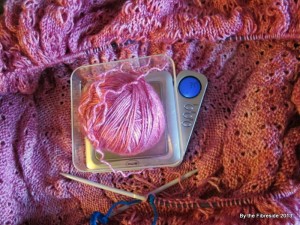Today I felt mentally prepared to face the Lighthouse shawl again. I was getting further and further into the border, and becoming more and more convinced I was going to run out of yarn. So today I dug out my scale and left a little early for work, which gave me time to take an initial weight reading, rip back the edging for 25 body stitches, and take another reading. Then it was time for knitter math.
I think knitter math is one of the big stumbling blocks for new knitters. Big yarn companies don’t help the matter by making cute little patterns in books that you see at big-box craft stores to inspire people to knit them and then printing big warnings on them:
NOT USING THIS EXACT YARN WILL CAUSE YOUR SCARF TO SPONTANEOUSLY COMBUST!
DON’T BLAME US IF YOUR HAT CAN DOUBLE AS A BATHTUB IF YOU DON’T USE OUR YARN!
Unless you’re forced into it by necessity, or you immediately have a mentor or a community around you that can tell you otherwise, of course you trust those warnings. And so you see the cute pattern that calls for Brand X yarn, and you buy the requisite number of balls and the required needle size (not understanding what gauge is at this point, most likely), and you knit it up, and maybe it works and maybe it doesn’t, and if it doesn’t, you put it down to your lack of skill as a knitter. But that’s not it at all. It’s all about the knitter math, and knitter math? It’s not that scary.
I say that from the perspective of one who just this year has really started to get knitter math. I MacGyvered a pattern for my final project, which was all knitter math, but even six months or a year ago, faced with the Lighthouse shawl situation, I might have given in and taken it to a knitting group for help. But it’s just been over the last little bit that knitter math has started to make sense to me. I’ve internalized it now, and I understand how it works. I may still need to think quite hard about it, but once I’ve come at the problem a few times, I’m pretty sure I come to the right solution.
Take the Lighthouse shawl. My weight measurement was 2.4 g of yarn for each 25 body stitches worked into the edging. Great! A place to start. At 576 to work, that’s about 55 g of yarn needed for the edging. I ripped back the edging and got 23.

So I merrily tinked back another row. And got 25.5 grams. I tinked back two more rows over the course of the day, including one of the multi-wrap stitch rows. Got 32 grams. And stopped.
Time for more math, because if I just kept tinking back to 55 grams, the wave section of the shawl – which was already one pattern repeat short and growing shorter – was going to be non-existent. I thought about just knitting the border from that point. Surely, my math was wrong. Surely it wouldn’t take this much yarn for the knitted-on border! But no, I wanted to do some math and see.
So I calculated approximately how many stitches were in the four-row repeat, and then how many stitches were in that 25-body-stitches-worked in my original measurement. It came out to about 488 stitches. If each tinked row is only 576, then it made sense that I was getting pretty close to the same weight per row tinked. This was no good. To get the 55 g I needed to do the edging, I would need to take far too much out of the wave section. I thought for a little bit, then tinked one more row.

At this point, six months ago, I would have frozen and wondered what to do. But that was then. Now, I have knitter math, and access to a very impressive collection of knitting books at my local library, including several books on edge treatments. But first, more math.
With about 35 grams of yarn, I can knit approximately 7117 stitches in the border (35 g / 2.4 g x 488 stitches), which means for every body stitch, I can use about 12 stitches for the border, or 24 for two (7117 stitches / 576 stitches to work). That’s a much shallower border than the original (at 39 stitches for two), but I’m sure I can find a shallower edge treatment that will look equally good in one of the library books. It also gives me a ballpark, so I don’t look at an edge treatment that will take too much yarn compared to what I have left.
See? Knitter math. It’s brilliant, and you have to trust the numbers. What it isn’t is intuitive. You need to learn about knitting, how the numbers work, and what they tell you. And that comes with experience and practice. But once you understand knitter math, the world is your oyster. Yarn substitutions. Pattern adjustments. Gauge differences. Nothing is impossible if you have knitter math.
